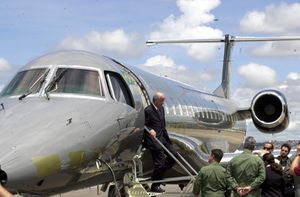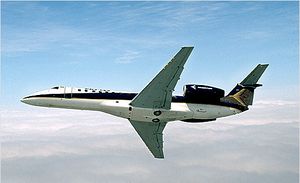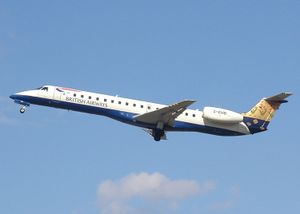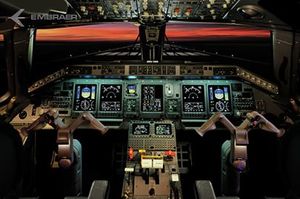PlaneSpottingWorld welcomes all new members! Please gives your ideas at the Terminal.
Embraer ERJ 145 family
| Embraer 135/140/145 Regional Jet Family | |
|---|---|
| Type | Regional jet |
| Manufacturer | Embraer |
| Maiden flight | August 11, 1995 |
| Introduced | 1989 |
| Status | In Service |
| Primary users | ExpressJet Airlines (262) American Eagle Airlines |
| Number built | >900 |
| Unit cost | US$16.08M - 22.18M (2006) |
| Developed from | Embraer EMB 120 Brasilia |
| Variants | R-99 Legacy |
The Embraer ERJ 145 family of regional jets are produced by Embraer, a Brazilian aerospace company. Family members include the ERJ 135, ERJ 140, ERJ 145, and Legacy. The ERJ 145 is the largest of the group. Each jet in the series is powered by two turbofan engines. The family's primary competition comes from the Canadair Regional Jet.
Contents
History
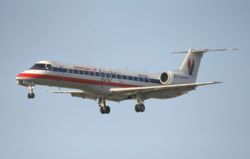
Early design
The ERJ 145 was launched at the Paris Airshow in 1989 as a stretched and turbofan-powered modification of the EMB 120 Brasilia. Key components of this design included:
- Straight wing (with winglets)
- Wing-mounted engines
- Range of 2500 km
- 75% parts commonality with the EMB 120.
Interim design
By 1990, Embraer engineers found that the result of wind-tunnel testing was safisfactory, and began considering a significantly different design from the EMB 120. A modified design was proposed which included:
- 22.3° swept wing (with winglet)
- Wing-mounted engine
- Range of 2500 km
Production design
The second design showed better performance in wind tunnel testing, but the combination of swept wings and wing-mounted engines required an undercarriage which was significantly higher than previous iterations. The design evolved until late 1991, at which time it was frozen. Though the aircraft went through many alterations before it was finalized, it did retain a few of the original influences of the EMB 120 such as the three abreast seating (2+1) configuration. The key features of the production design included:
- Rear mounted engines
- Swept wings (no winglets)
- "T"-tail configuration
- Range of 2500km
Derivatives
The ERJ 140 is based on the ERJ 145 with 96% parts commonality and the same crew-type rating. The only significant changes are a shorter fuselage, a slightly de-tuned engine and an increased range. At launch, Embraer estimated the cost of an ERJ 140 to be approximately $15.2 million U.S. dollars. The estimated cost of development of the ERJ 140 was $45 million US dollars. The ERJ 135, with an entry into service date of 1999, has 95% parts commonality with the ERJ 145, but is 11.7 feet (3.6 m) shorter.
The ERJ 145 seats 50 passengers, while the ERJ 140 seats 44, and the ERJ 135 seats 37. The ERJ 140 was designed with fewer seats in order to meet the needs of airlines based in the United States which have an agreement with the pilot's union as to the number of 50 seat aircraft that can be operated.
In 2003, Embraer entered a partnership with the Harbin Aviation Industry Group of Harbin, China. The resulting company, Harbin Embraer, began producing the ERJ 145 for the Chinese market by assembling kits premanufactured by other worldwide Embraer operations.
Operations
The first flight of the ERJ 145 was on 11 August, 1995, with the first delivery in December 1996 to ExpressJet Airlines (then the regional division of Continental Airlines). ExpressJet is the largest operator of the ERJ 145, with 270 of the nearly 1000 ERJ 145s in service. The second largest operator is American Eagle, with 206 ERJ 145 aircraft. Chautauqua Airlines also operates 95 ERJ 145s through its alliances with American Connection, Delta Connection, US Airways Express, Continental Express, and United Express. By some accounts, the ERJ 145 has a cost of ownership of about $2,500,000 per year.
As of early 2005, 74 ERJ 140s had been built. Though the marketing designation for this aircraft is ERJ 140LR, Embraer's internal designation, and also that of FAA certification, is EMB 135KL.
The ERJ 140 was introduced in September of 1999, first flew on June 27, 2000 and entered commercial service in July of 2001. American Eagle Airlines, the regional jet subsidiary of American Airlines, operates the majority of the ERJ 140s built. Mesa Airlines, and Chautauqua Airlines also operate the ERJ 140.
Variants
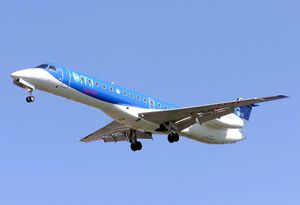
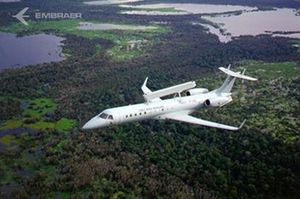
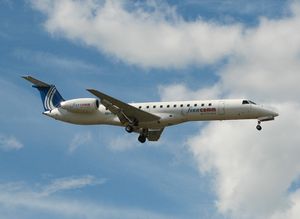
Since production began in 1995, Embraer has produced design modifications.
Civilian models
- ERJ 135ER - Extended range, although this is the Baseline 135 model. Simple shrink of the ERJ 145, seating thirteen fewer passengers, for a total of 37 passengers.
- ERJ 135LR - Long Range (increased fuel capacity and upgraded engines).
- ERJ 140ER - Simple shrink of the ERJ 145, seating six fewer passengers, for a total of 44 passengers.
- ERJ 140LR - Long Range (increased fuel capacity and upgraded engines).
- ERJ 145STD - The baseline original
- ERJ 145EU - Model for European market. Same fuel capacity as 145STD (4174kg) but an increased MTOW 19990kg
- ERJ 145ER - Extended Range, although this is the Baseline 145 model.
- ERJ 145EP - Same fuel capacity as 145ER (4174kg) but an increased MTOW 20990kg
- ERJ 145LR - Long Range (increased fuel capacity and upgraded engines).
- ERJ 145LU - Same fuel capacity as 145LR (5187kg) but an increased MTOW 21990kg
- ERJ 145MK - Same fuel capacity, landing weight (MLW) and MTOW as in the 145STD (4174kg), but a changed MZFW 17700kg
- ERJ 145XR - Extra-long Range (numerous aerodynamic improvements, including winglets, strakes, etc. for fuel efficiency, a ventral fuel tank (aft location) in addition to the two main larger capacity wing tanks( same tanks as in the LR models), increased weight capacity, higher top speed and more powerful engines).
- Legacy - Business jet variant is special variant modeled after an ERJ135. Main Article: Embraer Legacy
MTOW - Maximum TakeOff Weight; MZFW - Maximum Zero Fuel Weight
NOTE: The physical engines are the same (Rolls Royce Allison AE3007), however, the FADEC (Full Authority Digital Engine/Electronic Control) logic is what differs between the various models in regards to total thrust capability.
The extended range version, the ERJ-145ER, has Rolls Royce AE 3007A engines rated at 31.3kN with the option of more powerful AE 3007A1 engines. A, A1, A1P models are mechanically identical but differ in thrust due to variations in FADEC software. The A1E engine, however, has not only new software, but significantly upgraded mechanicals "The long range ERJ-145LR aircraft is equipped with Rolls Royce AE 3007A1 engines which provide 15% more power. The engines are flat rated at 33.1kN to provide improved climb characteristics and improved cruise performance in high ambient temperatures.
The extra long range ERJ-145XR aircraft is equipped with Rolls-Royce AE 3007A1E engines. The high performance engines provide lower specific fuel consumption (SFC) and improved performance in hot and high conditions. The engines also yield a higher altitude for one-engine-inoperable conditions."[1] ExpressJet is the sole operator of the ERJ 145XR.
Despite the multiple variants, a single type rating for the ERJ135/140/145 will allow pilots to fly this fleet. Companies like ExpressJet Airlines utilise this benefit with their mix-fleet of ERJ135ER/LR and ERJ145EP/LR/XR. Shared type ratings of aircraft allow companies to save on expensive plot training, making the Embraer fleet even more attractive to prospective buyers. Other companies, such as Airbus, have made this more common than before; Boeing, on the other hand, has not been as successful with this concept.
Military models
- C-99A - Transport model
- EMB 145SA (R-99 model A) - Airborne Early Warning model
- EMB 145RS (R-99 model B) - Remote sensing model
- EMB 145MP/ASW - Maritime patrol model
Operators
Military operators
Civilian operators
- ERJ 135 - In August 2006 a total of 113 ERJ 135 aircraft (all variants) remain in airline service, with 1 further firm order. Major operators include: American Eagle Airlines (39), Chautauqua Airlines (17) and ExpressJet Airlines (30). Smaller numbers of the aircraft are operated by some 9 other airlines.[1]
- ERJ 140 - In August 2006 a total of 74 ERJ 140LR aircraft remain in airline service, with American Eagle Airlines (59) and Chautauqua Airlines (15).[1]
- ERJ 145 - In August 2006 a total of 661 ERJ 145 aircraft (all variants) remain in airline service, with 6 further firm orders. Major operators include: Aerolitoral (19), Alitalia Express (14), BA Connect (28), Bmi regional (11), LOT Polish Airlines (11), Luxair (8), PGA - Portugália (8), Régional (28), American Eagle Airlines (108), Chautauqua Airlines (63), ExpressJet Airlines (244), Freedom Airlines (20), Mesa Airlines (16) and Trans States Airlines (48). Some 13 other airlines also operate the aircraft in smaller numbers.[1]
Accident history
The ERJ 145 family of aircraft has an outstanding service record with no reported crashes or fatalities due to mechanical malfunction. There have been a small number of reported incidents involving the ERJ 145. In one case a Rio-Sul pilot descended beyond the normal rates and landed at a speed significantly higher than the normal landing speed. This aircraft tail section bent and was dragged along the runway. In the other case, a Continental Express (ExpressJet) flight overran a Cleveland runway in blizzard conditions; there were no injuries and the aircraft was returned to service. Another ExpressJet aircraft crashed on takeoff in Beaumont, Texas during a training flight; that aircraft was a total loss, but again no injuries were sustained.
On May 2, 2006 two ERJ 145s were involved in separate incidents at two U.S. airports. The first incident involved a Continental Express jet blowing a tire on its left-side landing gear on takeoff at Bush Intercontinental Airport in Houston, Texas. The plane landed safely with no injuries.[2] The second incident involved a American Eagle flight which also blew out a tire on takeoff at Chicago's O'Hare International Airport. The plane skidded off the runway coming to rest 25 feet away in the grass. There were no injuries reported.[3].
A BA Citiexpress Aircraft overshot the runway at Hannover on landing with no injuries to passengers or crew. On June 18, 2006, another incident involved a Continental Express (ExpressJet) ERJ 145. Flight 2482 from Corpus Christi, TX (CRP) to Houston Intercontinental (IAH), made an emergency landing in Victoria, TX after an engine fire filled the lavatory and cabin with smoke. [4]
Specifications
General characteristics
- Crew: 3 (pilot, co-pilot, flight attendant)
- Capacity:
- ERJ 135: 37 passengers
- ERJ 140: 44 passengers
- ERJ 145: 50 passengers
- Length:
- ERJ 135: 26.33 m
- ERJ 140: 28.45 m (93 ft 4 in)
- ERJ 145: 29.9 m (98 ft 0 in)
- Wingspan: 20.04 m (65 ft 9 in)
- Height: 6.76 m (22 ft 2 in)
- Wing area: 51.2 m² (551 ft²)
- Empty:
- ERJ 140: 11,740 kg (25,88102 lb)
- ERJ 145: 11,667 kg (25,722 lb)
- Loaded:
- ERJ 140: 17,100 kg (37,700 lb)
- Maximum takeoff:
- ERJ 135: 22,500 kg
- ERJ 140: 21,100 kg (46,500 lb)
- ERJ 145: 22,000 kg (48,501 lb)
- ERJ 145XR: 24,100 kg (53131 lb)
- Powerplant: 2× Rolls-Royce AE 3007A turbofans, 33.0 kN (7,420 lbf) thrust each
Performance
- Maximum speed: 834 km/h (518 mph, Mach 0.78)
- Range:
- ERJ 135: 3,361 km
- ERJ 140: 3,019 km (1,876 miles)
- ERJ 145ER:' 2,963 km (1,841 miles)
- Service ceiling: 11,278 m (37,000 ft)
- Rate of climb:
- ERJ 140/145: 780 m/min (2,560 ft/min)
- Wing loading:
- ERJ 140: 334 kg/m² (68 lb/ft²)
- Thrust-to-weight:
- ERJ 145: 0.58:1
References
- ↑ 1.0 1.1 1.2 Flight International, 3-9 October 2006
- ERJ 145 information at Airliners.net
- Embraer Legacy Super Mid-Size Corporate Jet AeroSpace Technology website
- Information on Harbin Embraer
- EMB-145 Press Release for Rio-Sul Crash
- Endres, Gunter and Gething, Mike. (2002). Aircraft Recognition Guide, (2nd Ed.). New York: Harper Collins Publishers. ISBN 0-00-713721-4
External links
Related content
Related development
Comparable aircraft
- Bombardier Canadair Regional Jet (CRJ-100/200 series)
- Fairchild-Dornier 328JET
- Fairchild-Dornier 528
- ARJ-21
Designation sequence
- EMB 110 - EMB 120 - EMB 121 - ERJ 135 - ERJ 140 - ERJ 145 - 170 - 175 - 190 - 195
Related lists
Template:Active military aircraft of the United States
Agricultural: EMB 202 Ipanema
Civil: EMB 110 Bandeirante · EMB 120 Brasilia · EMB 121 Xingu · ERJ 145 family (Legacy 600) · E-Jets (Lineage)
Military: EMB 312 Tucano · EMB 314 Super Tucano · AMX · R-99
Built under licence: EMB 326GB Xavante · EMB 712 Tupi · EMB 810D Seneca · EMB 820C Navajo
In development/proposed: Phenom 100 · Phenom 300
Not developed: CBA 123 Vector
Lists relating to aviation | |
|---|---|
| General | Timeline of aviation · Aircraft · Aircraft manufacturers · Aircraft engines · Aircraft engine manufacturers · Airports · Airlines |
| Military | Air forces · Aircraft weapons · Missiles · Unmanned aerial vehicles (UAVs) · Experimental aircraft |
| Notable incidents and accidents | Military aviation · Airliners · General aviation · Famous aviation-related deaths |
| Records | Flight airspeed record · Flight distance record · Flight altitude record · Flight endurance record · Most produced aircraft |
de:Embraer ERJ-145-Familie el:EMB-145 es:Embraer 145 fr:Embraer ERJ-135 fr:Embraer ERJ-145 it:Embraer ERJ-145 lb:Embraer ERJ-145 nl:Embraer ERJ 145 ja:エンブラエル ERJ 145 pt:Embraer ERJ-135 pt:Embraer ERJ-140 pt:Embraer ERJ-145 sr:Ембраер ЕРЈ 145 фамилија sv:Embraer ERJ 135 sv:Embraer ERJ 140 sv:Embraer ERJ 145
